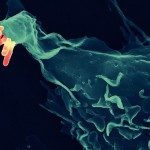Link to Pubmed [PMID] – 21317555
Virulence 2011 Jan-Feb;2(1):54-7
Invasive bacterial pathogens such as Shigella flexneri force their uptake into non-phagocytic host cells. Upon internalization, they rupture the endocytic vacuole and escape into the host cell cytoplasm. Recent studies applying fluorescence resonance energy transfer (FRET) based methods to track host-pathogen interactions have provided insights into the process of bacterial infection at the single cell level. We have previously reported that the vacuolar escape of invasive bacteria into the host cellular cytosol can be tracked by fluorescence microscopy using a FRET CCF4/β-Lactamase reporter assay. Here, we show that our vacuolar rupture assay can also be analyzed by flow cytometry constituting an important alternative to data acquisition by microscopy. Whereas analysis of our assay by fluorescence microscopy offers precise spatiotemporal resolution, flow cytometry analysis represents a high-throughput method that allows efficient and fast quantification of a large number of events and can further improve future research on vacuolar escape.


